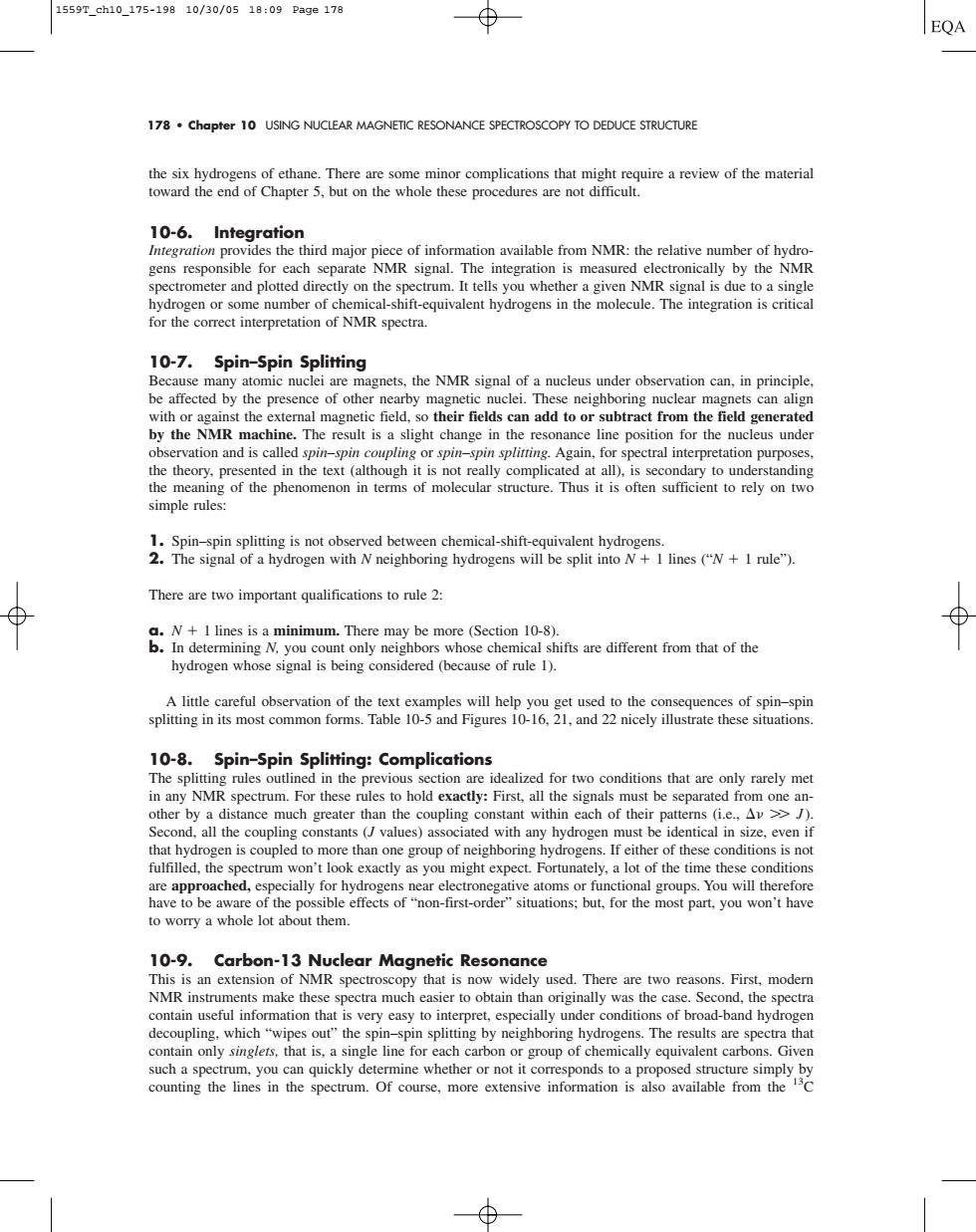正在加载图片...

1559rch10175-19910/30/0518:09Pag0178 178.chapter 10 USING NUCLEAR MAGNETIC RESONANCE SPECTROSCOPY TO DEDUCE STRUCTURE Inte piece of information available from NMR:the relative number or each sparate NMR signal.The is measured by the NME r of che for the correct interpretation of NMR spectra. 10-7.Spin-Spin Splitting ets,the NMR with or against the xtemal magnetic field,so their fields can add to or subtract from the field generated by the Ihe result is a slight change in the resonance ine position for the the theor presented in the text (althoug it is not really complicated at all),is secondary to und tanding g of the phenomenon in terms of molecular structure.Thus it is often sufficient to rely on two There are two important qualifications to rule 2: hydrogen whose signal is being considered (because of rule 1). A little careful observation of the text examples will help t used to the consequences of spin-spin spttingin its most common forms.Table 10-5 and Figures106and 2 nicely llustrate these sitations. 10-8. Spin-Spin Splitt ng:Co mplications trum for the other by a distance much greater than the coupling constant within each of their pattems (ie..) coupng constants values)as with any hydrogen must beid e,even fulfilled.the spectrum won't look exactly as you might expect.Fortunately.a lot of the time these conditions ar approached, to worry a whole lot about them. 10-9.Carbon-13 Nuclear Magnetic Resonance s an extension NMR opy that is nov widely used.There are two reasons.First.modem contain useful information that is very easy to interpret,especially under conditions of broad-band hydroger decoupling.which"wipes out"the spin-spin splitting by neighboring hydrogens.The results are spectra that carbo n or group of ch mically equivalent cathe six hydrogens of ethane. There are some minor complications that might require a review of the material toward the end of Chapter 5, but on the whole these procedures are not difficult. 10-6. Integration Integration provides the third major piece of information available from NMR: the relative number of hydrogens responsible for each separate NMR signal. The integration is measured electronically by the NMR spectrometer and plotted directly on the spectrum. It tells you whether a given NMR signal is due to a single hydrogen or some number of chemical-shift-equivalent hydrogens in the molecule. The integration is critical for the correct interpretation of NMR spectra. 10-7. Spin–Spin Splitting Because many atomic nuclei are magnets, the NMR signal of a nucleus under observation can, in principle, be affected by the presence of other nearby magnetic nuclei. These neighboring nuclear magnets can align with or against the external magnetic field, so their fields can add to or subtract from the field generated by the NMR machine. The result is a slight change in the resonance line position for the nucleus under observation and is called spin–spin coupling or spin–spin splitting. Again, for spectral interpretation purposes, the theory, presented in the text (although it is not really complicated at all), is secondary to understanding the meaning of the phenomenon in terms of molecular structure. Thus it is often sufficient to rely on two simple rules: 1. Spin–spin splitting is not observed between chemical-shift-equivalent hydrogens. 2. The signal of a hydrogen with N neighboring hydrogens will be split into N 1 lines (“N 1 rule”). There are two important qualifications to rule 2: a. N 1 lines is a minimum. There may be more (Section 10-8). b. In determining N, you count only neighbors whose chemical shifts are different from that of the hydrogen whose signal is being considered (because of rule 1). A little careful observation of the text examples will help you get used to the consequences of spin–spin splitting in its most common forms. Table 10-5 and Figures 10-16, 21, and 22 nicely illustrate these situations. 10-8. Spin–Spin Splitting: Complications The splitting rules outlined in the previous section are idealized for two conditions that are only rarely met in any NMR spectrum. For these rules to hold exactly: First, all the signals must be separated from one another by a distance much greater than the coupling constant within each of their patterns (i.e., J ). Second, all the coupling constants (J values) associated with any hydrogen must be identical in size, even if that hydrogen is coupled to more than one group of neighboring hydrogens. If either of these conditions is not fulfilled, the spectrum won’t look exactly as you might expect. Fortunately, a lot of the time these conditions are approached, especially for hydrogens near electronegative atoms or functional groups. You will therefore have to be aware of the possible effects of “non-first-order” situations; but, for the most part, you won’t have to worry a whole lot about them. 10-9. Carbon-13 Nuclear Magnetic Resonance This is an extension of NMR spectroscopy that is now widely used. There are two reasons. First, modern NMR instruments make these spectra much easier to obtain than originally was the case. Second, the spectra contain useful information that is very easy to interpret, especially under conditions of broad-band hydrogen decoupling, which “wipes out” the spin–spin splitting by neighboring hydrogens. The results are spectra that contain only singlets, that is, a single line for each carbon or group of chemically equivalent carbons. Given such a spectrum, you can quickly determine whether or not it corresponds to a proposed structure simply by counting the lines in the spectrum. Of course, more extensive information is also available from the 13C 178 • Chapter 10 USING NUCLEAR MAGNETIC RESONANCE SPECTROSCOPY TO DEDUCE STRUCTURE 1559T_ch10_175-198 10/30/05 18:09 Page 178